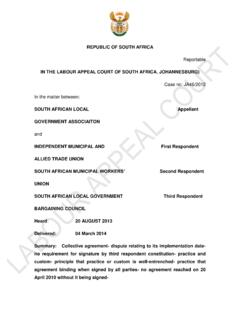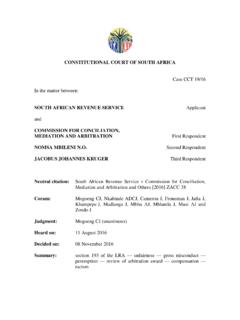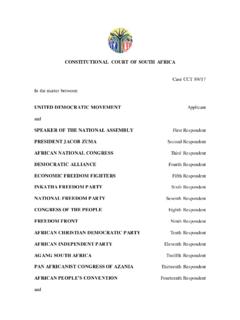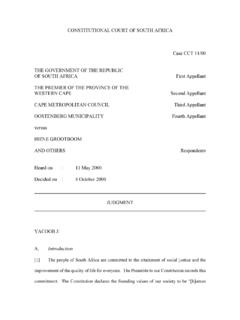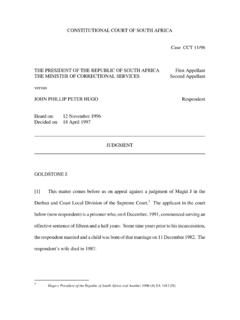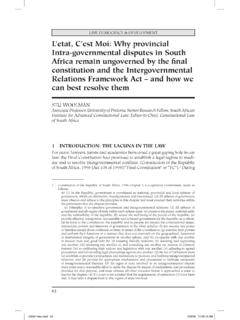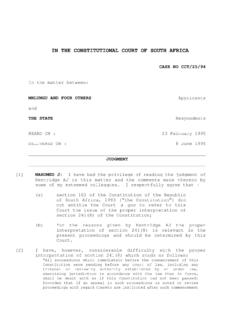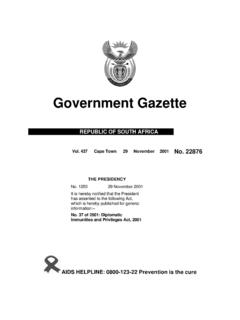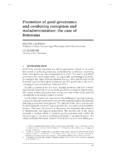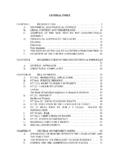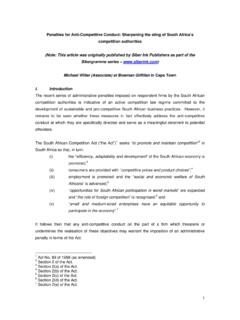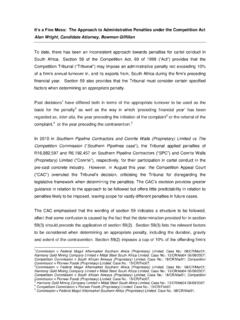Transcription of IN THE LABOUR APPEAL COURT OF SOUTH AFRICA, …
1 IN THE LABOUR APPEAL COURT OF SOUTH africa , JOHANNESBURG Reportable Case no: JA 15/16 In the matter between: NATIONAL UNION OF METALWORKERS OF SOUTH africa (NUMSA) obo MEMBERS Appellant and SOUTH african AIRWAYS SOC LIMITED First Respondent SAA TECHNICAL SOC LIMITED Second Respondent Heard: 13 September 2016 Delivered: 31 May 2017 Summary: Extension of a collective agreement signed by majority unions to non-parties in terms of s23(1)(d) of the LRA- principle of majoritarianism whether a settlement agreement a collective agreement capable of extension to non-parties Held a matter of mutual interest is one in which the trade union and the employer parties have a material and simultaneous interest which relates to the employment relationship and can be reduced to, or regulated by a collective agreement - issues covered in s189(2)
2 Are manifestly mutual interest issues - a retrenchment agreement between an employer and a trade union settling a retrenchment dispute is therefore a collective agreement capable of extension in terms of s 23(1)(d) by virtue of the principle of majoritarianism which finds expression in s23(1)(d) as well as in section 189(1) and 189(A) - 2 s23 is a deliberate choice by the legislature to limit the rights enshrined in s23 of the Constitution in order to attain orderly collective bargaining and fair and expeditious resolution of disputes in appropriate instances - The application of s 23(1)(d) to the s 189 process is necessary and justifiable to ensure orderly and peaceful consultation process aimed at minimising dismissals and contributing to economic viability.
3 Coram: Tlaletsi DJP, Molemela JA and Savage AJA JUDGMENT TLALETSI DJP Introduction [1] This is an APPEAL against the order of the LABOUR COURT (per Myburgh AJ), dismissing the appellant s application brought in terms of s 189A (13) of the LABOUR Relations Act1 (the LRA). In the application, the appellant sought to interdict SOUTH african Airways (SAA) and SOUTH african Technical (SOC) Ltd (SAAT), both the first and second respondents respectively, from proceeding with a large-scale retrenchment exercise pending compliance with a fair [2] The essential question that the LABOUR COURT had to determine was whether a retrenchment agreement concluded with unions representing the majority of employees in the workplace, and extended in terms of s 23(1)(d)3 of the LRA, 1 Act 66 of 1995.
4 2 Section 189A(13) provides that: (13) If an employer does not comply with a fair procedure, a consulting party may approach the LABOUR COURT by way of an application for an order- (a) compelling the employer to comply with a fair procedure; (b) interdicting or restraining the employer from dismissing an employee prior to complying with a fair procedure; (c) directing the employer to reinstate an employee until it has complied with a fair procedure; (d) make an award of compensation, if an order in terms of paragraphs (a) to (c) is not appropriate. 3 23. Legal effect of collective agreement (1) A collective agreement binds - (a) the parties to the collective agreement; (b) each party to the collective agreement and the members of every other party to the collective agreement, in so far as the provisions are applicable between them; (c) the members of a registered trade union and the employers who are members of a registered employers organisation that are party to the collective agreement if the collective agreement regulates (i) terms and conditions of employment; or 3 in effect settled any dispute that non-union member employees and minority union members had about the retrenchment process.
5 The APPEAL is with leave of the LABOUR COURT . [3] The APPEAL was heard on 17 September 2016. In the course of time, it came to our attention that a judgment of this Court4 on which the parties and the LABOUR COURT relied for part of its decision was a subject of APPEAL in the Constitutional COURT . With agreement of the parties our judgment was withheld pending the judgment of the Constitutional COURT which was decided on 21 February The parties were given an opportunity to file further written submissions addressing the judgment of the Constitutional COURT . The appellant filed its supplementary submissions on 24 March 2017 and the respondents on 20 March 2017.
6 What then follows is our judgment. Factual Background. [4] The factual background is in essence common cause. The appellant is the National Union of Metalworkers of SOUTH africa (NUMSA), a trade union duly registered in accordance with the provisions of the The second and further appellants are its members. SAA is the National Carrier. SAAT is a subsidiary of SAA and provides it with technical services. [5] During the 2013/14 financial year, SAA made a loss of about billion. As a result, SAA undertook to save the costs of employment by embarking on a reduction of a vast number of jobs. The estimated reduction was to save an amount of about R350 million per annum. (ii) the conduct of the employers in relation to their employees or the conduct of the employees in relation to their employers; (d) employees who are not members of the registered trade union or trade unions party to the agreement if - (i) the employees are identified in the agreement; (ii) the agreement expressly bind the employees; and (iii) that trade union or those trade unions have as their members the majority of employees employed by the employer in the workplace.
7 4 Association of Mineworkers & Construction Union v Chamber of Mines of SA acting in its own name & on behalf of Harmony Gold Mining Co (Pty) Ltd [2016] ZALAC 11; (2016) 37 ILJ 1333 (LAC); [2016} 9 BLLR 872 9 (LAC). 5 Association of Mineworkers and Construction Union and Others v Chamber of Mines of SOUTH africa and Others [2017] ZACC 3; (2017) 38 ILJ 831 (CC); 2017 (3) SA 242 (CC). 6 Aviation Union of Southern africa (AUSA), a trade union which was the first applicant in the COURT a quo is not pursuing the APPEAL . 4 [6] SAA employed 4265 employees, of whom about 80% belonged to either National Transport Movement (NTM), SOUTH african Cabin Crew Association (SACCA) or United Association of SOUTH africa (UASA).]
8 The three are unions recognised by SAA. The appellant had only 78 members (less than 2%) and was unrecognised. SAAT employed 2485 employees of whom 77 % belonged to UASA and SOUTH african Transport and Allied Workers Union (SATAWU), the two recognised unions. NTM, Solidarity and the appellant also had membership but were unrecognised. [7] On 22 April 2015, SAA issued a notice of retrenchment in terms of s 189(3) (the notice. Although there was initially an objection to only one notice being issued, the appellant and UASA accepted that a single notice issued would suffice for all the affected unions. A single facilitation process was agreed upon. Two facilitators from the CCMA7 were appointed, and a facilitated consultation process was thereupon undertaken in terms of s 189A (17) of the LRA for both SAA and SAAT as agreed.)
9 [8] The consultation process involved seven registered unions referred to above and two management representative bodies at SAA and SAAT respectively. The 60-day period provided for in s 189(A) (7) elapsed on 20 June 2015. On this day, the consultation process had not been concluded. The period was extended first to 9 July 2015, and later to 22 July 2015 and 22 August 2015, respectively. It is not disputed that the parties had over the course of some 3 months conducted nine facilitated consultation sessions and 45 private consultation sessions. [9] Certain events that led to the application in the LABOUR COURT took place during the course of the consultation process. On 4 July 2015, the appellant raised a number of issues during the consultation meeting.
10 The main issue was a demand for disclosure by the respondents of information relating to the commercial rationale and alternatives to dismissals. SAA adopted the position that the information relating to the commercial rationale and cost saving measures were already explained in the notice in terms of s 189(3) of the LRA, and that the request by the appellant amounted to duplication of 7 The Commission for Conciliation Mediation and Arbitration. 5 information already provided and a mere delaying tactic. Although the other union parties had promised to support the appellant s request for information, they withheld their support at this meeting.
